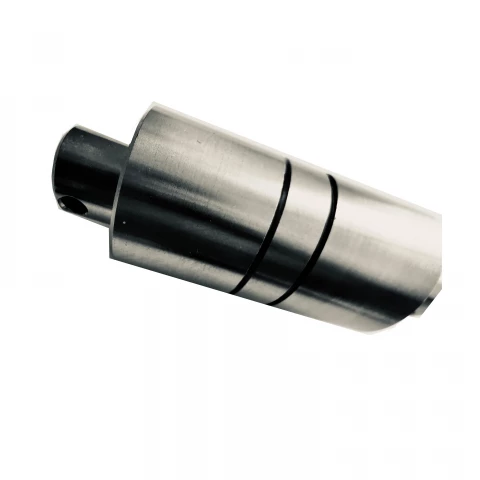Ascentta Polarization Dependent Free Space Circulator (635nm)
Description
The compact and high-performance three-port fiber optic circulator from Ascentta, Inc. is a versatile optical device that enables simultaneous signal transmission from port 1 to port 2 and from port 2 to port 3.
Designed for use in DWDM systems with fiber gratings and other reflective components, this circulator delivers exceptional performance. Ascentta also manufactures multiport circulator modules with a maximum of N<=8 ports.
Ascentta Polarization Dependent Free Space Circulator (635nm)
Specifications |
|
|---|---|
| Wavelength: | 635 nm |
| Bandwidth: | -- nm |
| Power: | 1.0 W |
| Isolation Range: | 20-23dB |
| Transmission: | -- % |
| Insertion Loss (23℃, All SOP*) (1→2, Or 2→3) Max: | 0.6 dB |
| Extinction Ratio Min.: | 28 dB |
| Directivity (1→3, Or 3→1) Min.: | 30 dB |
| Clear Aperture: | 1.8 mm |
| Operation Temperature: | +10 to +50 °C |
| Storage Temperature: | 0 to +60 °C |
Features
- Compact and high-performance three-port fiber optic circulator
- Simultaneous signal transmission from port 1 to port 2 and from port 2 to port 3
- Ideal for use in DWDM systems with fiber gratings and reflective components
Applications
- Fiber optic communication systems
- Dense Wavelength Division Multiplexing (DWDM) systems
- Fiber optic sensing and instrumentation
- Optical signal routing and switching
- Research and development in fiber optics
For pricing, technical or any other questions please contact the supplier
- No registration required
- No markups, no fees
- Direct contact with supplier
-
Ships from:
United States
-
Sold by:
-
On FindLight:
since 2020
Frequently Asked Questions
The operating wavelengths for the circulator core are 532nm, 635nm, 650nm, 780nm, 850nm, 980nm, 1030nm, and 1064nm.
The Transmitting Direction is 1→2, 2→3.
The typical and minimum Isolation values at 23℃ (room temperature) for each wavelength are as follows: - 532nm: 23dB (Typ.), 20dB (Min.) - 635nm: 23dB (Typ.), 20dB (Min.) - 650nm: 23dB (Typ.), 20dB (Min.) - 780nm: 25dB (Typ.), 21dB (Min.) - 850nm: 25dB (Typ.), 21dB (Min.) - 980nm: 27dB (Typ.), 22dB (Min.) - 1030nm: 27dB (Typ.), 22dB (Min.) - 1064nm: 27dB (Typ.), 22dB (Min.)
The typical and maximum Insertion Loss values at 23℃ for each wavelength are as follows: - 532nm: 0.4dB (Typ.), 0.6dB (Max.) - 635nm: 0.4dB (Typ.), 0.6dB (Max.) - 650nm: 0.4dB (Typ.), 0.6dB (Max.) - 780nm: 0.3dB (Typ.), 0.5dB (Max.) - 850nm: 0.3dB (Typ.), 0.5dB (Max.) - 980nm: 0.3dB (Typ.), 0.5dB (Max.) - 1030nm: 0.3dB (Typ.), 0.5dB (Max.) - 1064nm: 0.3dB (Typ.), 0.5dB (Max.)
The minimum Extinction Ratio for each wavelength is 28 dB. The Extinction Ratio is the ratio of the power of the orthogonal polarization states of light in a fiber.
The minimum Directivity for each wavelength is 30 dB. The Directivity is the measure of the intensity (power per unit surface) radiated by an antenna in the direction of its strongest emission.
The Package Dimensions (Cylinder) in millimeters for each wavelength are as follows: - 532nm: Ф16xL27 - 635nm: Ф16xL33 - 650nm: Ф16xL33 - 780nm: Ф19xL39 - 850nm: Ф19xL39 - 980nm: Ф19xL53 - 1030nm: Ф19xL53 - 1064nm: Ф19xL53
The operating temperature range is from 10 to 50 degrees Celsius, and the storage temperature range is from 0 to 60 degrees Celsius.
This information isn't directly provided in your input. The 'Ordering Information' section indicates that several custom configurations are possible, including varying port types, wavelengths, apertures, maximum power, and diameter and length of the component. Customers are encouraged to contact Ascentta with their specific needs.
SOP indicates the orientation of the plane of polarization which can vary across different points in an optical system. Here it is mentioned as "All SOP", meaning the listed specifications apply for all states of polarization.

